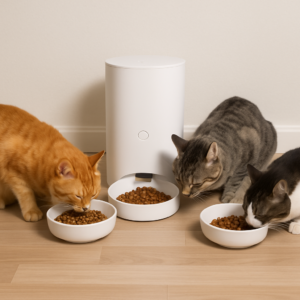Have you ever found your cat scaling your bookshelves or transforming your couch into a scratching post?
Are you struggling with complaints from customers about the durability of your cat trees? Frequent returns and dissatisfaction can damage your reputation and bottom line.
Every day, your products face the wear and tear of climbing, scratching, and lounging, which are natural feline behaviors. Poorly chosen materials can lead to quick degradation, unhappy customers, and a loss of repeat business. Imagine the frustration of seeing your cat trees fail to meet the high standards expected by pet stores, online retailers, and discerning cat owners.
By selecting the right materials for your cat trees, you can ensure exceptional durability, enhance customer satisfaction, and secure the long-term success of your product line. Invest in solid wood, sisal, and other high-quality materials to create cat trees that withstand rigorous use. This not only boosts their appeal and longevity but also makes them a favorite among retailers and cat owners alike, ultimately strengthening your brand’s reputation in the competitive pet product industry.
What is the Best Material for a Cat Tree?
Wood:
- Advantages: Solid woods like pine, oak, and beech are celebrated for their sturdiness and longevity. A cat tree made from these materials can withstand vigorous play and the test of time, making them a premium choice.
- Disadvantages: They tend to be more expensive compared to other materials and can be heavier, which might make them harder to move around.

Engineered Wood:
- Advantages: Medium-density fiberboard (MDF) and particleboard are cost-effective alternatives to solid wood. These materials are easier to shape and assemble, making them popular choices for DIY projects.
- Disadvantages: While budget-friendly, they are less durable over the long term and may not hold up as well to the intense activity of some cats.

Sisal:
- Advantages: Sisal is the gold standard for scratching surfaces. Its rough texture is highly appealing to cats, encouraging them to scratch and maintain healthy claws.
- Disadvantages: While extremely durable, sisal can eventually wear out and may need to be replaced over time.

Carpet:
- Advantages: Carpet is another popular material for covering the surfaces of cat trees. It is durable, provides excellent traction for climbing, and cats love the feel for scratching.
- Disadvantages: Carpet can be challenging to clean and may retain odors over time if not properly maintained.

Faux Fur/Fleece:
- Advantages: These materials are incredibly soft and provide a cozy lounging area for cats. They can make the cat tree more inviting and comfortable for resting.
- Disadvantages: Similar to carpet, faux fur and fleece can be difficult to clean and might wear out faster with heavy use.

Metal:
- Advantages: Metal components are sometimes used in the core structure of a cat tree for reinforcement. They offer exceptional strength and stability, ensuring the tree remains upright even during the most energetic play sessions.
- Disadvantages: Metal can add extra weight to the cat tree and might not be as aesthetically pleasing in a home setting.

Exploring Further: Key Considerations for Cat Tree Materials
Durability: A durable cat tree should be able to withstand frequent use and the force exerted by a cat’s claws. Solid wood and sisal are top choices for long-lasting durability.
Comfort: Comfort is essential for the lounging areas of the cat tree. Soft materials like faux fur or fleece make excellent choices for platforms and beds.
Scratching Surfaces: Cats have a natural instinct to scratch to mark their territory and maintain their claws. Sisal and carpet are both excellent materials for this purpose, offering satisfying textures that cats love.
Stability: Stability is crucial to prevent the cat tree from tipping over. Solid wood and metal reinforcements can provide the necessary support for a sturdy structure.
Ease of Cleaning: Materials that are easy to clean or replace are highly preferable. Faux fur and carpet can be challenging to clean, while sisal and solid wood are easier to maintain.

Why Material Matters in a Cat Tree
Choosing the best material for your cat tree isn’t just about durability and cost. It’s also about understanding your cat’s preferences and needs. Cats are natural climbers and scratchers, and they seek out textures that satisfy these instincts. A well-designed cat tree can incorporate multiple materials to cater to different behaviors. For instance, a tree with a solid wood frame, sisal-covered scratching posts, and faux fur lounging areas can provide a comprehensive solution that appeals to various feline instincts.

Optimizing Your Cat Tree Materials for Business Success
Choosing the right materials for your cat trees is a critical decision that impacts your business strategy, customer satisfaction, and overall profitability. Here’s how to make the best choices for your business:
1. Know Your Customer Base
Understanding your target market is crucial. Are your customers looking for premium, durable cat trees, or are they more price-conscious? This knowledge will help you decide whether to invest in high-end materials like solid wood and sisal, or more economical options like MDF and particleboard.
2. Balance Quality and Cost
While high-quality materials may have higher initial costs, they often lead to increased durability and customer satisfaction. This can result in fewer returns, better reviews, and enhanced brand reputation. Weigh the long-term benefits of quality against the upfront investment to find the right balance.
3. Align with Your Business Model
Your business model plays a significant role in material selection. If you operate on a high-volume, low-margin basis, cost-effective materials are essential. Conversely, if your focus is on low-volume, high-margin products, investing in premium materials can justify higher prices and attract a niche market.

4. Emphasize Sustainability
Eco-friendly materials are increasingly important to consumers. Incorporating recycled or sustainably sourced materials can enhance your brand’s appeal and attract environmentally conscious customers. While the initial costs might be higher, the long-term benefits of customer loyalty and market differentiation can be substantial.
5. Embrace Flexibility and Innovation
Stay adaptable and open to new materials and technologies. Innovations in recycled materials and manufacturing processes can offer improved durability and cost-effectiveness. Being at the forefront of these advancements can provide a competitive edge in the market.
By carefully considering these factors, you can select the best materials for your cat trees, ensuring they meet the needs of your customers while supporting your business goals. This strategic approach will help you create products that stand out in the market, driving success and growth for your brand. Ecopetfashions will help you success.
Conclusion: Creating the Perfect Cat Tree

In summary, the best material for a cat tree depends on a balance between durability, comfort, and your cat’s unique preferences. Solid wood offers unparalleled sturdiness, while engineered wood provides a cost-effective alternative. Sisal remains the top choice for scratching surfaces, and materials like carpet and faux fur add the necessary comfort for lounging. By understanding these materials’ benefits and drawbacks, you can select the perfect combination that meets your cat’s needs and enhances their playtime and relaxation.
Investing in a high-quality cat tree not only protects your furniture but also provides a dedicated space for your cat to engage in their natural behaviors. With the right materials, your cat tree can become a beloved feature in your home, offering endless hours of entertainment and comfort for your feline friend.
More Related Questions

What kind of cat tree do cats prefer?
Cats generally prefer tall cat trees that allow them to climb and perch high, satisfying their instinct to seek elevated vantage points. Cat trees around 60 inches or taller with multiple levels, perches, and platforms are ideal as they offer various spots for climbing, jumping, and resting. Trees with sisal-wrapped posts for scratching and enclosed hideaways or “condos” for hiding and feeling secure are also highly favored. Soft, comfortable materials like carpet or faux fur provide cozy areas for lounging and napping. Stability is crucial; cats prefer sturdy trees that don’t wobble. Additionally, built-in toys and placing the tree near a window can enhance your cat’s enjoyment.
How do I find the perfect cat tree?
To find the perfect cat tree, consider the size of your space and your cat’s size. Opt for a stable tree with a wide, heavy base, preferably made of solid wood for durability. Most cats enjoy high perches, so a tree that is at least 3-6 feet tall is ideal. Look for features like enclosed condos for hiding, various scratching surfaces in different textures (sisal, carpet, cardboard), and built-in toys for play. Ensure the tree matches your home’s decor and can accommodate multiple cats if needed. For younger or older cats with limited mobility, choose a tree that is easily accessible and low to the ground.
What is the safest real tree for cats?
When choosing a real Christmas tree for a home with cats, non-drop varieties are safer as they shed fewer needles. Fir trees are generally less harmful than other types, though they can still cause irritation if ingested. Artificial trees are often recommended as they don’t have sharp needles, don’t require water or preservatives, and don’t shed. To make any tree safer, block access to it, secure the tree to prevent tipping, avoid using preservatives in the water, cover the water base, regularly clean fallen needles, and use pet-safe deterrents around the tree area.
How long does a cat tree last?
The lifespan of a cat tree can vary from a few months to several years, depending on the quality of materials and construction. Higher quality trees made from sturdy materials like wood tend to last longer, especially if they are used by calm or older cats. Frequent use by energetic cats can wear out a tree more quickly. Regular maintenance, such as tightening screws and replacing worn parts, can extend its life. Signs that a cat tree needs replacing include instability, damaged scratching surfaces, and worn-out components. Typically, a well-made cat tree lasts 1-2 years, with some lasting up to 4 years.
What is the best wood for a cat tree?
Pine is a popular choice for cat trees due to its affordability, availability, and safety when properly prepared. Kiln-dried pine is especially suitable as it is free from excess sap and moisture. Spruce and birch are also safe options for cat trees. It’s important to avoid treated wood, which can contain harmful chemicals. Hardwoods, while durable, can be heavy and expensive. Using untreated, kiln-dried wood is preferable for safety and durability. Sealing the wood with a cat-safe finish, such as water-based polyurethane, can further ensure safety. Covering the wood with carpet or sisal rope adds extra comfort and scratching surfaces.






